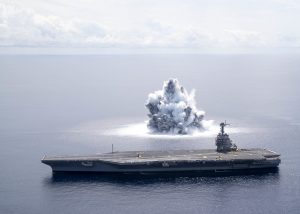The Navy on Tuesday said the USS Gerald R. Ford (CVN-78) aircraft carrier completed sea trials this week to mark the end of its Planned Incremental Availability (PIA) and is now getting ready for workups before its first deployment, planned in the fall.
The six-month PIA followed the end of the ship’s Full Ship Shock Trials (FSST) in August off the coast of Mayport, Fla. (Defense Daily, Aug. 10, 2021).
FSST followed an 18-month Post-Delivery Test and Trials (PDT&T) period that lasted until April 2021 (Defense Daily, May 5).
The PIA began in September 2021 to conduct modernization and maintenance work at shipbuilder Huntington Ingalls Industries’ Newport News Shipbuilding [HII] shipyard. This included repairing any damage incurred by the shock trials.
The Navy said at the start of the PIA the ship underwent detailed inspections to assess potential damage. The last carrier to experience shock trials was the Nimitz-class USS Theodore Roosevelt (CVN-71) in 1987. The service used those results and further modeling and simulation to estimate the potential impact from the Ford FSST.

An official noted shock trials repairs were less than expected.
“Ford required only 20 percent of the repair work we saw with TR,” Rear Adm. James Downey, program executive officer for aircraft carriers, said in a statement.
He also said of the required FSST-related repairs about 85 percent were completed by ship’s force rather than work needed to be done by the shipyard.
Downey said the Navy will continue to incorporate lessons learned from these shock trials to further harden future ships in the class including the future USS John F. Kennedy (CVN-79), Enterprise (CVN-80), and Doris Miller (CVN-81).
During the PIA, the Navy and industry team also performed additional required modernization and maintenance on CVN-78 concurrent with the shock trial repairs. This ranged from things like updating the ship’s galley to modernizing the Consolidated Afloat Networks and Enterprise Services (CANES) system.
Downey underscored that since the Ford-class have reconfigured command and control spaces, modernization work is streamlined by not having to cut into decks and overheads.
“Historically, about 40 percent of modernization work on Nimitz-class carriers goes into rip out, which involves cutting and welding. The Navy specifically designed Ford with a flexible infrastructure, so you can build in new capabilities to enhance system integration that facilitate immediate operational gains for the warfighter,” he said.
The Navy reiterated that four months into the PIA the ship’s 11th and final Advanced Weapons Elevator was turned over to the crew. The AWE uses electromagnetic motors, which allows fewer sailors to more ordnance from weapons magazines to the flight deck faster than with traditional hydraulic systems (Defense Daily, Dec. 23, 2021).
“We look forward to folding what we learned into the entire Gerald R. Ford class, extending the Navy’s power projection advantage around the globe,” Lucas Hicks, HII vice president of the Gerald R. Ford and John F. Kennedy (CVN-79) aircraft carrier programs, said in a statement.
Following the PIA, CVN-78 sailed from HII’s facility to Naval Station Norfolk on Feb. 28, where the ship will now undergo months of training and certification to prepare it for its inaugural deployment planned for this upcoming fall.
The Navy said during the workups the ship will embark its air wing, CVW-8, and start qualification tests, flight deck certification, three phases of air warfare training and complete a Combat Systems Operational Readiness Evaluation.
During the PIA, the Ford was moved from the Ford-class program office that oversees construction, PMS 378, to the in-service aircraft carriers program office that oversees sustainment, maintenance and modernization of in-service carriers, PMS 312.